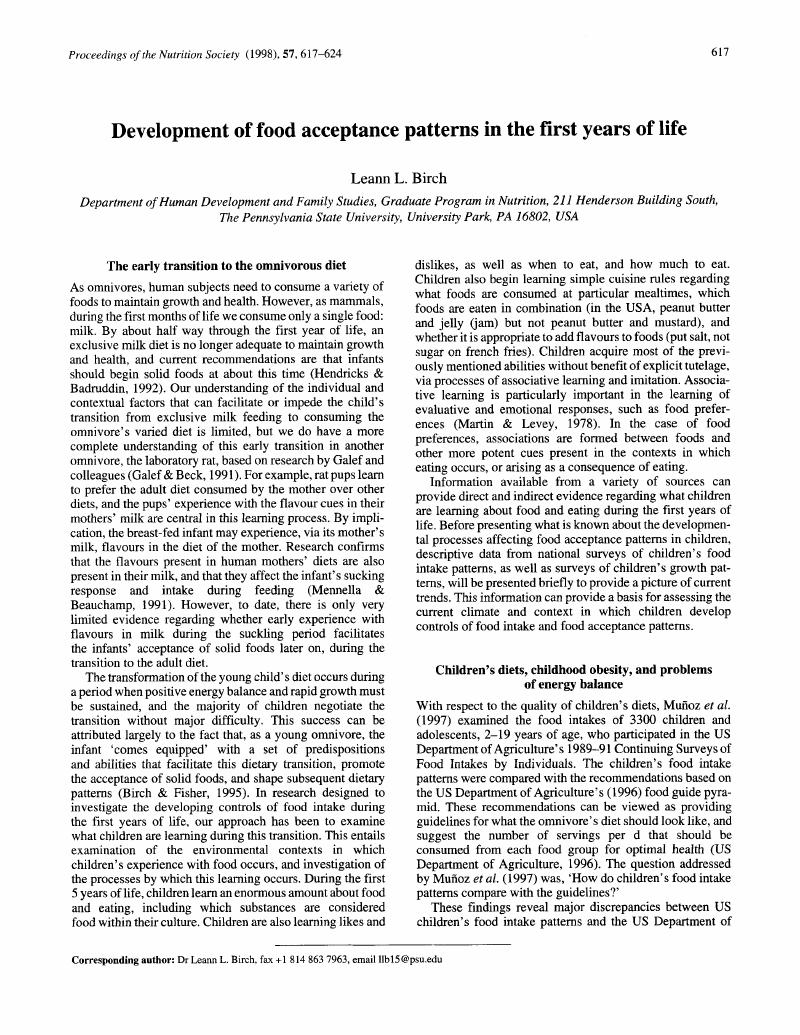Crossref Citations
This article has been cited by the following publications. This list is generated based on data provided by Crossref.
Hadders-Algra, M.
and
Dirks, T.
2000.
De motorische ontwikkeling van de zuigeling.
p.
81.
Gassin, Anne-Laure
2001.
Helping to promote healthy diets and lifestyles: the role of the food industry.
Public Health Nutrition,
Vol. 4,
Issue. 6a,
Buttriss, Judy
2002.
Nutrition, health and schoolchildren.
Nutrition Bulletin,
Vol. 27,
Issue. 4,
p.
275.
Douglas, Jo
2002.
Psychological Treatment of Food Refusal in Young Children.
Child and Adolescent Mental Health,
Vol. 7,
Issue. 4,
p.
173.
Longbottom, P. J.
Wrieden, W. L.
and
Pine, C. M.
2002.
Is there a relationship between the food intakes of Scottish 5½−8½‐year‐olds and those of their mothers?.
Journal of Human Nutrition and Dietetics,
Vol. 15,
Issue. 4,
p.
271.
Anderson, Annie S.
2002.
Editorial: Nutrition messages under the microscope.
Journal of Human Nutrition and Dietetics,
Vol. 15,
Issue. 2,
p.
97.
Cerro, N
Zeunert, S
Simmer, KN
and
Daniels, LA
2002.
Eating behaviour of children 1.5–3.5 years born preterm: Parents’ perceptions.
Journal of Paediatrics and Child Health,
Vol. 38,
Issue. 1,
p.
72.
Haire-Joshu, Debra
Brownson, Ross C
Nanney, M.S
Houston, Cheryl
Steger-May, Karen
Schechtman, Kenneth
and
Auslander, Wendy
2003.
Improving dietary behavior in African Americans: the Parents As Teachers High 5, Low Fat Program.
Preventive Medicine,
Vol. 36,
Issue. 6,
p.
684.
Young, Laura
Anderson, Jennifer
Beckstrom, Leslie
Bellows, Laura
and
Johnson, Susan L.
2003.
Making New Foods Fun for Kids.
Journal of Nutrition Education and Behavior,
Vol. 35,
Issue. 6,
p.
337.
Couch, Sarah C.
Daniels, Stephen R.
and
Deckelbaum, Richard J.
2003.
Current concepts of diet therapy for children with hypercholesterolemia.
Progress in Pediatric Cardiology,
Vol. 17,
Issue. 2,
p.
179.
Kremers, Stef P.J
Brug, Johannes
de Vries, Hein
and
Engels, Rutger C.M.E
2003.
Parenting style and adolescent fruit consumption.
Appetite,
Vol. 41,
Issue. 1,
p.
43.
Marshall, Teresa A.
Levy, Steven M.
Broffitt, Barbara
Eichenberger-Gilmore, Julie M.
and
Stumbo, Phyllis J.
2003.
Patterns of beverage consumption during the transition stage of infant nutrition.
Journal of the American Dietetic Association,
Vol. 103,
Issue. 10,
p.
1350.
Sotelo, Yêda de Oliveira Marcondes
Colugnati, Fernando A. B.
and
Taddei, José Augusto de Aguiar Carrazedo
2004.
Prevalência de sobrepeso e obesidade entre escolares da rede pública segundo três critérios de diagnóstico antropométrico.
Cadernos de Saúde Pública,
Vol. 20,
Issue. 1,
p.
233.
Fox, Mary Kay
Pac, Susan
Devaney, Barbara
and
Jankowski, Linda
2004.
Feeding infants and toddlers study: what foods are infants and toddlers eating?.
Journal of the American Dietetic Association,
Vol. 104,
Issue. ,
p.
22.
2004.
Position of the American Dietetic Association: Dietary Guidance for Healthy Children Ages 2 to 11 Years.
Journal of the American Dietetic Association,
Vol. 104,
Issue. 4,
p.
660.
Blake, Anthony A.
2004.
Flavor Perception.
p.
172.
Haire-Joshu, Debra
Kreuter, Matthew K.
Holt, Cheryl
and
Steger-May, Karen
2004.
Estimates of Fruit and Vegetable Intake in Childhood and Adult Dietary Behaviors of African American Women.
Journal of Nutrition Education and Behavior,
Vol. 36,
Issue. 6,
p.
309.
Sakashita, R
Inoue, N
and
Kamegai, T
2004.
From milk to solids: a reference standard for the transitional eating process in infants and preschool children in Japan.
European Journal of Clinical Nutrition,
Vol. 58,
Issue. 4,
p.
643.
Pac, Susan
McMahon, Kathleen
Ripple, Michelle
Reidy, Kathleen
Ziegler, Paula
and
Myers, Esther
2004.
Development of the start healthy feeding guidelines for infants and toddlers 11The Start Healthy Feeding Guidelines for Infants and Toddlers is a collaborative project between the American Dietetic Association and Gerber Products Company. Funding provided by Gerber Products Company. The authors wish to thank the Start Healthy Expert Panel—Nancy F. Butte, PhD, MPH, RD; Kathleen Cobb, MS, RD, DC/N; Johanna Dwyer, DSc, RD; Laura Graney, MS, RD, CD, CBE; William C. Heird, MD; and Karyl Rickard, PhD, RD, FADA—for their guidance and input in the development of the guidelines and review of this paper, the pediatric experts—Jane Clark, PhD; Anna M. Dusick, MD, FAAP; Rhoda Erhardt, MS; Jennifer O. Fisher, PhD; and Suzanne Morris, PhD—for sharing their expertise, Sherrie Harris and Cheryl Castelo for their expert library services, and Leah Beltran for her technical assistance..
Journal of the American Dietetic Association,
Vol. 104,
Issue. 3,
p.
455.
Young, Laura
Anderson, Jennifer
Beckstrom, Leslie
Bellows, Laura
and
Johnson, Susan L.
2004.
Using Social Marketing Principles to Guide the Development of a Nutrition Education Initiative for Preschool-Aged Children.
Journal of Nutrition Education and Behavior,
Vol. 36,
Issue. 5,
p.
250.





